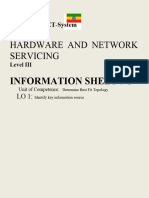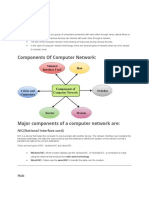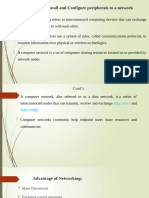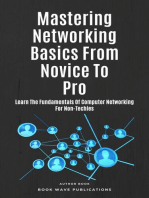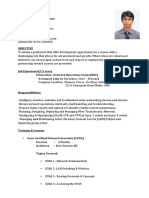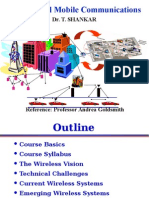0 ratings0% found this document useful (0 votes)
66 viewsComputer Networks 1
The document discusses different types of computer networks:
1. Local area networks (LANs) connect devices within a small physical area like a classroom or building.
2. Metropolitan area networks (MANs) span larger distances like a city using more networking components.
3. Wide area networks (WANs) connect devices over even greater distances, such as the Internet, using long-distance telecommunications.
Networks can also be categorized as peer-to-peer, server-based, or client-based depending on which devices control network operations and resources. The OSI model defines seven layers of network functionality from the physical layer up to the application layer.
Uploaded by
jillCopyright
© © All Rights Reserved
Available Formats
Download as PPTX, PDF, TXT or read online on Scribd
0 ratings0% found this document useful (0 votes)
66 viewsComputer Networks 1
The document discusses different types of computer networks:
1. Local area networks (LANs) connect devices within a small physical area like a classroom or building.
2. Metropolitan area networks (MANs) span larger distances like a city using more networking components.
3. Wide area networks (WANs) connect devices over even greater distances, such as the Internet, using long-distance telecommunications.
Networks can also be categorized as peer-to-peer, server-based, or client-based depending on which devices control network operations and resources. The OSI model defines seven layers of network functionality from the physical layer up to the application layer.
Uploaded by
jillCopyright
© © All Rights Reserved
Available Formats
Download as PPTX, PDF, TXT or read online on Scribd
You are on page 1/ 35
Part 1
Presentation by: G. A. Sarmiento, CpE
Open Minded ka ba?!
Communication describes a process in which
two or more computer or devices transfer
data, instructions and information.
Sharing of device (eg. Printer)
Sharing of Program/ Software
Sharing of files
Sharing of Data
Sharing of high-speed internet
connection
Access centered database
1. Human Network
◦ Family Network
◦ Peer Network
◦ Contact Network
2. Computer Network
◦ Local Area Network (LAN)
◦ Metropolitan Area Network (MAN)
◦ Wide Area Network (WAN)
Human Network
In its broadest sense, a network consists of
two or more entities, or objects, sharing
resources and information. There are
networks that don’t involve computers, and
those networks are everywhere. You have
grown accustomed to working with them,
possibly without even knowing it.
Computer Network
A computer network consists of two or more
computing devices that are connected in
order to share the components of your
network (its resources) and the information
you store there,
Family Network:
◦ Most people belong to a family network in which
related people share their resources and
information. This sharing is bi-directional because
even the youngest family members share
information of some sort. As the family grows, so
does the network.
Peer Network
Outside the family, there is a community that
offers a wider array of resources than the typical
family can provide. Naturally, it makes sense to
connect the family to this community to take
advantage of the wealth of resources available
around town. This type of information/resource
sharing can be as simple as loaning a hammer to
a neighbor, car-pooling with work associates, or
helping a friend with his or her homework. All of
these activities involve sharing, or trading,
resources. This kind of network is represented by
a two-way relationship, a give and take among
equals or peers.
Contact Network
Anyone who has looked for a job knows that
one of the best ways to find a job is to
network. That is, create a list of friends and
associates who will help you find the perfect
job. The more people you meet and get to
know, the better your chances of obtaining
work.
LAN
• If the network is contained within a relatively small area,
such as a classroom, school, or single building, as shown
in Figure 1.6, it is commonly referred to as a local area
network (LAN). This type of network has the lowest cost
and least overall capability of the three geographic
classifications. Because the pieces of equipment in a LAN
are in relatively close proximity, LANs are inexpensive to
install. Despite their decreased capability, however, their
closeness and resultant low costs typically result in the use
of the fastest technology on a LAN. Thus, this network
classification usually has the highest speed components
and fastest communications equipment before the other
network classifications see such equipment using the same
speeds. This is because it takes less overall investment to
get the smaller network running the faster equipment.
LANs, therefore, are commonly considered the building
blocks for creating larger networks.
Metropolitan Area Network (MAN)
◦ As the computers get further apart, a LAN becomes
more difficult to install, and additional measures such as
additional communications equipment may need to be
employed. When the network spans the distance of a
typical metropolitan city, as shown in Figure 1.7, it can
be referred to as a metropolitan area network (MAN).
Although this term is beginning to lose its popular use,
the concept of the network outgrowing its local confines
and requiring additional resources still applies. Much of
the same technology, such as the fast networking
components and communications equipment used in
LANs, can be used in MANs, but more are required, so
this classification is not quite as technologically
advanced as are LANs. Although the speeds achieved in
a MAN are typically as high as in a LAN, it requires high-
speed connections, such as fiber optics. Increasing the
distance and the technology levels increases the relative
installation and operation costs of MANs.
Wide Area Network (WAN)
◦ The MAN outgrows its usefulness when the network
must expand beyond the confines of the typical
metropolitan area. When the network spans a larger
area, as shown in Figure 1.8, it is classified as a
wide area network(WAN). Because of the extensive
distances over which WANs communicate, they use
long-distance telecommunications networks for
their connections, which increases the costs of the
network. The Internet is just a giant WAN.
Another method used to classify networks focuses
on the roles the networked computers play in the
network’s operation, and more specifically on which
computer controls that operation. There are two
basic types of role classifications for networks:
peer-to-peer networks and server-based networks.
The difference between the two revolves around
which computer is in charge of the network. A third
classification, client-based networks, has come into
existence because of the increased capabilities of
the typical client computer.
Peer-to-Peer Networks
◦ All computers on a peer-to-peer network can be
considered equals, as shown in Figure 1.9. That is to
say, no one computer is in charge of the network’s
operation. Each computer controls its own information
and is capable of functioning as either a client or a
server depending on which is needed at the time.
◦ It is popular as home networks and for use in small
companies because they are inexpensive and easy to
install. Most operating systems(the software that runs
the basic computer functionality) come with peer-to-
peer networking capability built in. The only other cost
involved with setting up a peer-to-peer network comes
into play if a computer does not have a network interface
card, or NIC (the de-vice that physically connects your
computer to your network’s cabling), already installed.
Server-Based Networks
◦ Unlike peer-to-peer networks that operate without
central control and are difficult to secure, a server-based
network offers centralized control and is designed for
secured operations, as shown in Figure 1.10. While there
are still both clients and servers on a server-based
network, a dedicated server controls the network. A
dedicated server is one that, for all practical purposes,
operates solely as a server.
◦ A dedicated server on a server-based network services
its network clients by storing data, applications, and
other resources, and then providing access to those
resources when called for by a client. When a client
requests a resource such as a document, the server
sends the whole resource (the document) over the
network to the client, where it is processed and later
returned to the server for continued storage.
◦ Dedicated servers can also control the entire network’s
security from one central location or share that control
with other specially configured servers.
Client-Based Networks
◦ Client-based networks are a further refinement to
the concept of a server-based network that relieves
the heavy burden on the network’s capacity
resulting from frequent server-performed
transactions. A client-based network takes better
advantage of the server’s powerful processors and
of the increasingly powerful computers used in
typical workstations. A client-based network
utilizes a client workstation’s power in processing
some functions locally while requesting additional
processing from a server whenever it is needed for
increased speed.
◦ Client-based network servers process requests
from clients and return just the results, rather than
sending the original resource to the client to be
processed and returned after computations are
complete. Client-based networks, therefore, take
advantage of the powerful processing capabilities
of both the client and the server.
OSI model
◦ OSI (Open Systems Interconnection) model was
created by the International Organization for
Standardization (ISO), an international standard-
setting body. It was designed to be a reference
model for describing the functions of a
communication system. It has seven layers, with
each layer describing a different function of data
traveling through a network.
Here is the graphical representation of these
layers:
The layers are usually numbered from the last
one, meaning that the Physical layer is consider
to be the first layer. It is good to learn these
layers, since there will certainly be a couple of
questions on the CCNA exam regarding them.
Most people learn the mnemonic “Please Do Not
Throw Sausage Pizza Away”.
Physical – defines how to move bits from one device to another. It details
how cables, connectors and network interface cards are going to work
and how to send and receive bits.
Data Link – encapsulates a packet in a frame. A frame contains a header
and a trailer that enable devices to communicate. A header, most
commonly, contains a source and a destination MAC address. A trailer
contains the Frame Check Sequence field, which is used to detect
transmission errors.
◦ The data link layer has two sub-layers:
1. Logical Link Control – used for flow control and error detection
2. Media Access Control – used for hardware addressing and
controlling the access method
Network – defines device addressing, routing, and path determination.
Device (logical) addressing is used to identify a host on a network (e.g.
by its IP address).
Transport – segments great chunks of data received from the upper
layer protocols. Establishes and terminates connections between two
computers. Used for flow control and data recovery.
Session – defines how to establish and terminate a session between the
two systems.
Presentation – defines data formats. Compression and encryption are
defined at this layer.
Application – this layer is the closest to the user. It enables network
applications to communicate with other network applications.
The following table shows which protocols
reside on which layer:
Abbreviations to remember:
◦ HTTP - Hypertext Transfer Protocol
◦ MIME - Multipurpose Internet Mail Extensions
◦ SSL - Secure Sockets Layer
◦ NetBIOS - Network Basic Input/Output System
◦ TCP – Transmission Control Protocol
◦ UDP – User Datagram Protocol
◦ IP – Internet Protocol
◦ ICMP – Internet Control Messaging Protocol
◦ PPP – Point-to-Point Protocol
◦ HDLC - High-Level Data Link Control Network
Protocol
HTTP - Hypertext Transfer Protocol
The underlying protocol used by the World Wide
Web and this protocol defines how messages are
formatted and transmitted
MIME - Multipurpose Internet Mail Extensions
an extension of the original Internet e-mail
protocol that lets people use the protocol to
exchange different kinds of data files on the
Internet: audio, video, images, application
programs, and other kinds
SSL - Secure Sockets Layer
◦ Any computer in between you and the server can see
your credit card numbers, usernames and
passwords, and other sensitive information if it is
not encrypted with an SSL certificate.
NetBIOS - Network Basic Input/Output System
It provides services related to the session layer of
the OSI model allowing applications on separate
computers to communicate over a local area
network
TCP – Transmission Control Protocol
is a suite of communications protocols used to
interconnect network devices on the Internet.
TCP/IP implements layers of protocol stacks, and
each layer provides a well-defined network services
to the upper layer protocol.
UDP – User Datagram Protocol
used by programs running on different computers on a
network. UDP is used to send short messages called
datagrams but overall, it is an unreliable,
connectionless protocol.
IP – Internet Protocol
is a numerical label assigned to each device connected
to a computer network that uses the Internet Protocol
for communication.
ICMP – Internet Control Messaging Protocol
is an error-reporting protocol network devices like
routers use to generate error messages to the source IP
address when network problems prevent delivery of IP
packets. ICMP creates and sends messages to the
source IP address indicating that a gateway to the
Internet that a router, service or host cannot be reached
for packet delivery.
HDLC - High-Level Data Link Control Network
Protocol
is a group of protocols or rules for transmitting
data between network points. Data is organized
into a unit (called a frame) and sent across a
network to a destination that verifies its successful
arrival.
You are all given a topic of your own, present
this at the next meeting with a power point
presentation and hard copy.
In the presentation you “must” include the
following:
◦ Picture of the device
◦ Definition of the device
◦ What is it for?
◦ How it functions?
◦ Advantages and Disadvantages
1. Leslie Calma – Bridge
2. Mark Carballo – Hub
3. KC Cornista – Switch
4. Rancel Cruz – Router
5. Paul Descalzo – Modem
6. Jonas Gomez – Repeater
7. Kevin Hipolio – Gateway
8. Max Manuel – Repeater Hub
9. Timothy Oconer – Multilayer Switch
10. Xyra Salonga – Protocol Converter
11. Mark Soriano – Bridge Router
12. Andrea Sunga – Multiplexer
13. Paul Teodoro – Network Interface Controller
Mark Vallester – UTP Cable & STP Cable
14. Joel Yacas – Fiber Optic Cable
Reporting will be done randomly.
You might also like
- Networking: Computer Networking Section IVNo ratings yetNetworking: Computer Networking Section IV67 pages
- NETWORKS AND TRANSMISSION MEDIA ICT LESSON 6 (1)No ratings yetNETWORKS AND TRANSMISSION MEDIA ICT LESSON 6 (1)27 pages
- Overview of Networking: Understanding Network BasicsNo ratings yetOverview of Networking: Understanding Network Basics16 pages
- Soltech Computer Academy PC Know-How: (Networking)0% (1)Soltech Computer Academy PC Know-How: (Networking)43 pages
- What Is A Computer Network?: Networking in GeneralNo ratings yetWhat Is A Computer Network?: Networking in General19 pages
- Administrate Network and Hardware Peripherals100% (2)Administrate Network and Hardware Peripherals14 pages
- LO 2 - Install and Configure Peripherals To A NetworkNo ratings yetLO 2 - Install and Configure Peripherals To A Network49 pages
- Ambo University Woliso Campus, Technology and Informatics School Department of Computer ScienceNo ratings yetAmbo University Woliso Campus, Technology and Informatics School Department of Computer Science30 pages
- Lesson 5-Introducing Basic Network Concepts100% (1)Lesson 5-Introducing Basic Network Concepts33 pages
- Industrial Training Report: Bachelor of TechnologyNo ratings yetIndustrial Training Report: Bachelor of Technology45 pages
- Networking Programming with C++: Build Efficient Communication SystemsFrom EverandNetworking Programming with C++: Build Efficient Communication SystemsNo ratings yet
- Introduction to Internet & Web Technology: Internet & Web TechnologyFrom EverandIntroduction to Internet & Web Technology: Internet & Web TechnologyNo ratings yet
- Straight-Through Wired Cables Are Most Commonly Used To Connect A Host To Client. When We Talk AboutNo ratings yetStraight-Through Wired Cables Are Most Commonly Used To Connect A Host To Client. When We Talk About1 page
- Structuring System Data Requirements: Jeffrey A. Hoffer Joey F. George Joseph S. ValacichNo ratings yetStructuring System Data Requirements: Jeffrey A. Hoffer Joey F. George Joseph S. Valacich54 pages
- The Origins of Software: Jeffrey A. Hoffer Joey F. George Joseph S. ValacichNo ratings yetThe Origins of Software: Jeffrey A. Hoffer Joey F. George Joseph S. Valacich19 pages
- Determining System Requirements: Jeffrey A. Hoffer Joey F. George Joseph S. ValacichNo ratings yetDetermining System Requirements: Jeffrey A. Hoffer Joey F. George Joseph S. Valacich38 pages
- Managing The Information Systems Project: Jeffrey A. Hoffer Joey F. George Joseph S. ValacichNo ratings yetManaging The Information Systems Project: Jeffrey A. Hoffer Joey F. George Joseph S. Valacich40 pages
- Modern Systems Analysis and Design: The Systems Development EnvironmentNo ratings yetModern Systems Analysis and Design: The Systems Development Environment38 pages
- Technical Specifications: About Trinity 823No ratings yetTechnical Specifications: About Trinity 8231 page
- Md. Azizur Rahman Sumon: Planners Tower, 13 Floor, Suit#1 - 3No ratings yetMd. Azizur Rahman Sumon: Planners Tower, 13 Floor, Suit#1 - 33 pages
- Understanding Virtual Concatenation and Link Capacity Adjustment Scheme in SONET SDHNo ratings yetUnderstanding Virtual Concatenation and Link Capacity Adjustment Scheme in SONET SDH12 pages
- Management Information System CHAPTER 4No ratings yetManagement Information System CHAPTER 42 pages
- Wireless and Mobile Communications: Dr. T. ShankarNo ratings yetWireless and Mobile Communications: Dr. T. Shankar43 pages
- A Network Ready Device Is Directly Connected To A Mikrotik Routerboard 750 With A Correct U.T.PNo ratings yetA Network Ready Device Is Directly Connected To A Mikrotik Routerboard 750 With A Correct U.T.P6 pages
- Traffic Suppression and Storm Control Configuration: About This ChapterNo ratings yetTraffic Suppression and Storm Control Configuration: About This Chapter17 pages
- Sunnydale: Half Yearly Examination 2020 2021No ratings yetSunnydale: Half Yearly Examination 2020 202114 pages
- GSM Global System For Mobile Communications: Telecommunication EngineeringNo ratings yetGSM Global System For Mobile Communications: Telecommunication Engineering23 pages
- MXK: Intelligent Terabit Access ConcentratorNo ratings yetMXK: Intelligent Terabit Access Concentrator5 pages
- SJ-20140314093122-003-ZXA10 C300M&C350M (V4.0.1) Multi-Service Access Equipment Feature GuideNo ratings yetSJ-20140314093122-003-ZXA10 C300M&C350M (V4.0.1) Multi-Service Access Equipment Feature Guide158 pages
- Software-Defined Networks: A Systems ApproachFrom EverandSoftware-Defined Networks: A Systems Approach
- Overview of Networking: Understanding Network BasicsOverview of Networking: Understanding Network Basics
- Soltech Computer Academy PC Know-How: (Networking)Soltech Computer Academy PC Know-How: (Networking)
- What Is A Computer Network?: Networking in GeneralWhat Is A Computer Network?: Networking in General
- LO 2 - Install and Configure Peripherals To A NetworkLO 2 - Install and Configure Peripherals To A Network
- Ambo University Woliso Campus, Technology and Informatics School Department of Computer ScienceAmbo University Woliso Campus, Technology and Informatics School Department of Computer Science
- Industrial Training Report: Bachelor of TechnologyIndustrial Training Report: Bachelor of Technology
- Mastering Networking Basics From Novice To ProFrom EverandMastering Networking Basics From Novice To Pro
- Networking Programming with C++: Build Efficient Communication SystemsFrom EverandNetworking Programming with C++: Build Efficient Communication Systems
- Computer Knowledge Guide For All Competitive ExamsFrom EverandComputer Knowledge Guide For All Competitive Exams
- Introduction to Internet & Web Technology: Internet & Web TechnologyFrom EverandIntroduction to Internet & Web Technology: Internet & Web Technology
- Straight-Through Wired Cables Are Most Commonly Used To Connect A Host To Client. When We Talk AboutStraight-Through Wired Cables Are Most Commonly Used To Connect A Host To Client. When We Talk About
- Structuring System Data Requirements: Jeffrey A. Hoffer Joey F. George Joseph S. ValacichStructuring System Data Requirements: Jeffrey A. Hoffer Joey F. George Joseph S. Valacich
- The Origins of Software: Jeffrey A. Hoffer Joey F. George Joseph S. ValacichThe Origins of Software: Jeffrey A. Hoffer Joey F. George Joseph S. Valacich
- Determining System Requirements: Jeffrey A. Hoffer Joey F. George Joseph S. ValacichDetermining System Requirements: Jeffrey A. Hoffer Joey F. George Joseph S. Valacich
- Managing The Information Systems Project: Jeffrey A. Hoffer Joey F. George Joseph S. ValacichManaging The Information Systems Project: Jeffrey A. Hoffer Joey F. George Joseph S. Valacich
- Modern Systems Analysis and Design: The Systems Development EnvironmentModern Systems Analysis and Design: The Systems Development Environment
- Md. Azizur Rahman Sumon: Planners Tower, 13 Floor, Suit#1 - 3Md. Azizur Rahman Sumon: Planners Tower, 13 Floor, Suit#1 - 3
- Understanding Virtual Concatenation and Link Capacity Adjustment Scheme in SONET SDHUnderstanding Virtual Concatenation and Link Capacity Adjustment Scheme in SONET SDH
- Wireless and Mobile Communications: Dr. T. ShankarWireless and Mobile Communications: Dr. T. Shankar
- A Network Ready Device Is Directly Connected To A Mikrotik Routerboard 750 With A Correct U.T.PA Network Ready Device Is Directly Connected To A Mikrotik Routerboard 750 With A Correct U.T.P
- Traffic Suppression and Storm Control Configuration: About This ChapterTraffic Suppression and Storm Control Configuration: About This Chapter
- GSM Global System For Mobile Communications: Telecommunication EngineeringGSM Global System For Mobile Communications: Telecommunication Engineering
- SJ-20140314093122-003-ZXA10 C300M&C350M (V4.0.1) Multi-Service Access Equipment Feature GuideSJ-20140314093122-003-ZXA10 C300M&C350M (V4.0.1) Multi-Service Access Equipment Feature Guide





























